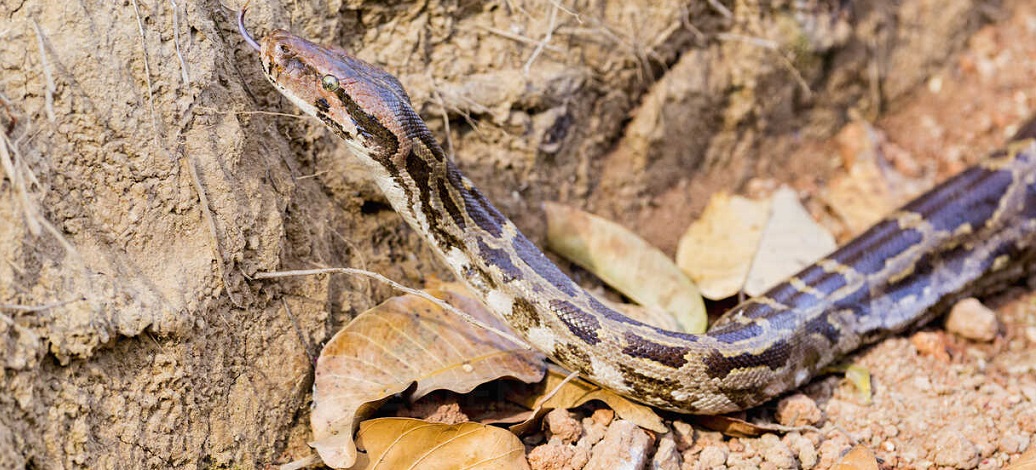Since ancient times, snakes have captivated human curiosity and instilled fear. Across various cultures, they have symbolised evil, as seen in the Biblical serpent and Indian mythological snake demons. Even the ancient Egyptians associated snakes with judgement and death. Unfortunately, this negative perception has impacted Indian Python adversely.
The Jungle Book’s Kaa in the Jungle of Kanha
Rudyard Kipling’s masterpiece, ‘The Jungle Book’ was inspired by Kanha National Park, the Indian Python is among the fauna species that call Kanha their home. Learn about the real-life Kaa, the second antagonist after Shere Khan of ‘The Jungle Book’.
A Brief Description of the Indian Python
The Indian python, scientifically known as Python molurus, is a substantial non-venomous species of python. Referred to as the Black-tailed python, Indian rock python, and Asian rock python, it exhibits a coloration ranging from whitish to yellowish, adorned with blotched patterns that vary from tan to dark brown hues. This coloration is influenced by its surroundings, with specimens from the hill forests of the Western Ghats and Assam appearing darker, while those from the Deccan Plateau and the Eastern Ghats tend to be lighter. Indian pythons inhabit various regions including India, southern Nepal, Pakistan, Sri Lanka, Bhutan, Bangladesh, and possibly northern Myanmar. Their habitats span diverse landscapes such as grasslands, savannas, swamps, marshes, rocky foothills, woodlands, open forests, and river valleys.
General Behaviour
Similar to the boas and anacondas found in the Americas, the python is a constrictor, relying on squeezing its prey to subdue it. While mammals are their preferred prey, pythons also consume birds, other animals, and occasionally fish, as they often inhabit areas near water bodies and are proficient swimmers. Pythons exhibit a stealthy hunting strategy, often concealing themselves among tree branches with their patterned skin, patiently awaiting the perfect moment to ambush their unsuspecting prey. Upon spotting their target, they swiftly strike with their head, seizing it before wrapping their powerful coils around it, preventing it from breathing. Remarkably, a large python can suffocate a deer and subsequently swallow it whole. Following such a substantial meal, the python may not need to feed again for up to a year. While authenticated reports of python attacks on humans are rare, they are plausible given that the largest recorded python measured over 32 feet (9.8 m) in length. Pythons boast a lifespan of over 20 years and are typically solitary creatures, except during mating season when males and females seek each other out. After laying her eggs, the female python coils around them to provide warmth for incubation. Young pythons face numerous natural predators, including eagles, crocodiles, large felines like leopards and tigers, and hyenas.
Snakes play a crucial role in regulating pest populations, including rodents, rabbits, and insects. In regions where snakes have been eliminated by humans, the unchecked proliferation of mice and rodents, known carriers of diseases, poses significant risks to human health.
Eating Habits of Indian Python
Indian Pythons, like many reptiles, follow a fascinating reproductive cycle that begins with mating rituals in the cooler months of December to February. Following successful mating, the female Indian Python embarks on the crucial task of laying her eggs from March to June. The female pythons can lay between 15 to 100 eggs in a single clutch. She wraps her powerful coils around them, providing warmth, and protection, and ensuring their safety throughout the incubation period. The female regulates the temperature of her eggs by shivering, thereby creating enough heat appropriate for the eggs to hatch.
Throughout the incubation period, which spans approximately 60 days, the mother python protects them by foregoing food and water to ensure safety. While the journey to adulthood is fraught with challenges, including predation and environmental hazards, by the age of 2 to 3 years, they reach sexual maturity, ready to continue the cycle of life. Indian Pythons are remarkable creatures known for their longevity, with some individuals defying the passage of time to live for up to 30 years. This extended lifespan allows them to play a vital role in maintaining the delicate balance of their ecosystems, ensuring their continued survival for generations to come.



